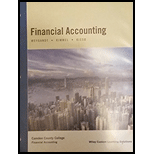
Concept explainers
(a)
Accounts receivable:
Accounts receivable refers to the amounts to be received with interest, within a short period from customers upon the sale of goods, and services on account. In other words, accounts receivable are amounts customers owe to the business. Accounts receivable is an asset of a business.
Bad debt expense:
Bad debt expense is an expense account. The amounts of loss incurred from extending credit to the customers are recorded as bad debt expense. In other words, the estimated uncollectible accounts receivable are known as bad debt expense.
Percentage-of-receivables basis:
It is a method of estimating the
Percentage-of-sales basis:
Credit sales are recorded by debiting (increasing) accounts receivable account. The bad debts is a loss incurred out of credit sales, hence uncollectible accounts can be estimated as a percentage of credit sales or total sales.
It is a method of estimating the bad debts (expected loss on extending credit), by multiplying the expected percentage of uncollectible with the total amount of net credit sale (or total sales) for a specific period. Under percentage of sales method, estimated bad debts would be treated as a bad debt expense of the particular period.
Allowance method:
It is a method for accounting bad debt expense, where uncollectible accounts receivables are estimated, and recorded at the end of particular period. Under this method, bad debts expenses are estimated, and recorded prior to the occurrence of actual bad debt, in compliance with matching principle by using the allowance for doubtful account.
Direct write-off method:
This method does not make allowance or estimation for uncollectible accounts, instead this method directly write-off the actual uncollectible accounts, by debiting bad debt expense, and by crediting accounts receivable. Under this method, accounts would be written off only when the receivables from a customer remain uncollectible.
The amount to be reported as bad debt expense, if Company M uses the direct write-off method of accounting for bad debts.
(b)
The amount of bad debts expense would be recorded by Company M.
(c)
The amount of bad debts expense would be recorded by Company M.
(d)
The amount of bad debt expense that would be recorded by Company M.
(e)
To describe: The weakness of reporting bad debt expense under direct write-off method.
Want to see the full answer?
Check out a sample textbook solution
Chapter 8 Solutions
FINANCIAL ACCOUNTING W/WILEY+ >IP<
- Need help with accountingarrow_forwardElmont Industries issues $2,400,000 of 8% bonds at 101. What is the amount of cash Elmont would receive from the sale? A. $2,373,000 B. $2,240,000 C.$2,424,000 D. $2,185,000 E. None of the above. Help mearrow_forwardPlease explain how to solve this financial accounting question with valid financial principles.arrow_forward
- Can you help me solve this general accounting problem with the correct methodology?arrow_forwardI am looking for a step-by-step explanation of this financial accounting problem with correct standards.arrow_forwardTyson manufacturing company produces and sells 120,000 units of a single product. Variable costs total $340,000 and fixed costs total $480,000. If each unit is sold for $12, what markup percentage is the company using?arrow_forward
- A company paid $36,000 for a 3-year insurance policy on January 1, 2024. The payment was recorded as a prepaid expense. What is the adjusting entry required on December 31, 2024?arrow_forwardThe financial statements of the Patterson Industries reported net sales of $875,000 and accounts receivable of $95,000 and $65,000 at the beginning of the year and end of the year, respectively. What is the receivables turnover ratio for Patterson?arrow_forwardI am looking for the correct answer to this general accounting question with appropriate explanations.arrow_forward

 AccountingAccountingISBN:9781337272094Author:WARREN, Carl S., Reeve, James M., Duchac, Jonathan E.Publisher:Cengage Learning,
AccountingAccountingISBN:9781337272094Author:WARREN, Carl S., Reeve, James M., Duchac, Jonathan E.Publisher:Cengage Learning, Accounting Information SystemsAccountingISBN:9781337619202Author:Hall, James A.Publisher:Cengage Learning,
Accounting Information SystemsAccountingISBN:9781337619202Author:Hall, James A.Publisher:Cengage Learning, Horngren's Cost Accounting: A Managerial Emphasis...AccountingISBN:9780134475585Author:Srikant M. Datar, Madhav V. RajanPublisher:PEARSON
Horngren's Cost Accounting: A Managerial Emphasis...AccountingISBN:9780134475585Author:Srikant M. Datar, Madhav V. RajanPublisher:PEARSON Intermediate AccountingAccountingISBN:9781259722660Author:J. David Spiceland, Mark W. Nelson, Wayne M ThomasPublisher:McGraw-Hill Education
Intermediate AccountingAccountingISBN:9781259722660Author:J. David Spiceland, Mark W. Nelson, Wayne M ThomasPublisher:McGraw-Hill Education Financial and Managerial AccountingAccountingISBN:9781259726705Author:John J Wild, Ken W. Shaw, Barbara Chiappetta Fundamental Accounting PrinciplesPublisher:McGraw-Hill Education
Financial and Managerial AccountingAccountingISBN:9781259726705Author:John J Wild, Ken W. Shaw, Barbara Chiappetta Fundamental Accounting PrinciplesPublisher:McGraw-Hill Education





